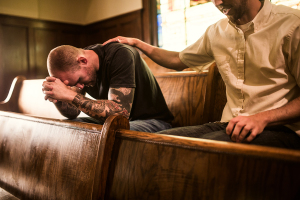Scholar responds to Eastern Orthodox apologists

John Carpenter, pastor and church historian, released an article, “Answering Eastern Orthodox Apologists Regarding Icons,” answering the claims Eastern Orthodox apologists use to target evangelicals. The article appears in the December 2018 edition of Themelios. Themelios is the Gospel Coalition’s peer-reviewed international academic theological journal, edited by D. A. Carson.
Q. Has Eastern Orthodoxy been drawing many evangelicals into its fold?
A. They’ve been claiming to. They claim that about half of their nearly 1 million followers are converts and many of those are former evangelicals. Frank Schaeffer, son of famous evangelical philosopher Francis Schaeffer, was drawn to them. I had a Greek professor in seminary who was a former evangelical who used his Greek class to recruit for his Orthodox church, that he claimed was the most ancient. Last year the “Bible Answer Man” Hank Hanegraff joined them. You’ll find Eastern Orthodox apologists on-line trying to win evangelicals.
Q: What is it about Eastern Orthodoxy that draws many evangelicals?
A: They are especially attracted to the Orthodox claims of historical roots back to the early church. They strongly appeal to those from serious Christian backgrounds, especially those with a formal theological education, people like my former Greek professor; people who see the early church as the pristine church to which they seek to return. The Orthodox are attractive to evangelicals who are tired of the showmanship and the superficiality of some evangelical worship.
Q: Aren’t Eastern Orthodoxy’s practices inherited from ancient times?
A: That’s definitely their claim. Rod Dreher, who wrote The Benedict Option, himself originally a Methodist who converted to Eastern Orthodoxy, claims, “Many evangelicals seek the early church; well here it is, in Orthodoxy.” But there’s many problems with that claim, notably that the Orthodox make icons a prominent part of their worship – “divine liturgy” they call it – and yet the early church strictly prohibited icons. The Orthodox claim that Luke painted the first icon – a picture of Mary – but there is no evidence anyone believed that prior to the Middle Ages, five hundred years after Luke. Augustine, who lived into the fifth century, wrote that no one knew what Mary looked like, so showing that the claim of Luke painting Mary hadn’t been spread by his time. Paul Finney, in his important book on art in the early church states, “No distinctly Christian art predates the year 200. This is a simple statement of fact.”
Q: What are icons? Are they different from decorations?
A: Icons aren’t merely decorations. An icon is, according to their own theologians, “a sacred image.” It’s an image of a saint or of Christ Himself that they use in worship; they will bow before it, pray before it, kiss it, use it as an “aid in worship.” The word “icon” is Greek and simply means “image” but now it is a technical term for the sacred images used in worship. But the early church believed that using such images was a violation of the second commandment (in Exodus 20:4). The pagan culture around the early church used many images in worship and the early Christians separated themselves from all such icons.
Q: Aren’t the images discovered in archaeology proof that the early church used icons?
A: The Orthodox will certainly claim that. But there is no real proof of that. One ancient church discovered by archaeologists in Dura-Europas, Syria has some images, frescos, on the walls. But, importantly, there are no images in the main room where the church actually met. And there is no evidence that the images that have been found are anything more than decorations, never becoming icons, images used in worship.
Q: What did the early church say about icons?
A: Not a lot but enough to make their position clear. There are four main sources from the early church on icons, first Origen, then the Council of Elvira, third Eusebius, and finally Epiphanius. While they vary some, they are unanimous in prohibiting icons. For example, Origen mocked the idea that images were helpful in worship. He believed the second commandment prohibited icons. He wrote that Christians “not only avoid temples, altars, and images, but are ready to suffer death when it is necessary,” rather than be involved in them.
Q: But wasn’t Origen a heretic?
A: He certainly taught some strange things and I wouldn’t recommend him as a theologian to follow. But soundness of Origen’s theology is not relevant to the validity of the historical reporting he provides. Origen gives us evidence to the practice of early Christian worship. On this topic, he’s valuable as a reporter. The bishops meeting in Elvira, Spain, in the early 4th century, did the same.
Q: But wasn’t the Council of Elvira just a local synod, so not authoritative over the whole church?
A: Like Origen, the Council of Elvira is valuable for the window it gives us into the early church. It also made a strict stand on icons, stating, “Pictures are not to be placed in churches, so that they do not become objects of worship and adoration.” That’s canon 36. Now, just because the bishops of Elvira concluded something doesn’t mean we have to follow it. But they show us what the early church was practicing. I cite Elvira not dogmatically, seeking instruction; if I did, I’d also have to follow their resolution for clerical celibacy. I cite it as historical evidence of what the church at the time practiced. Clearly, they didn’t allow icons; they were even more conservative about mere decorations than most of us modern evangelicals would be.
Q. That statement from that council seems definitive. How do Orthodox apologists answer it?
A: First, as we just discussed, they try to relegate it to the status of a minor, local synod and so not authoritative over the church. To me, that’s irrelevant. I’m an evangelical and so don’t see councils as ultimately authoritative any way. What they are valuable for is showing us what Christians in the early church believed. Second, they try to obfuscate the point, with debates about the fine points of translating the statement from Latin and arguing that it was only temporary, during the persecution, and so narrowing its intent so that it is, supposedly, irrelevant today. But Elvira, as one of the most important church councils after the close of the New Testament and before Nicea (in 325), is solid documentation for the practices of the early church at that time. It is an official testament, issued by representatives of the church in Spain, substantiating the church’s practice on images.
Q: Did Eusebius speak approvingly of icons?
A: No, he didn’t. Eusebius is known as the father of church history and like a good historian he often just reported on things dispassionately. He once reported on a statue of a woman, originally a pagan statue that by his time had been re-interpreted as the woman with the issue of blood the Lord Jesus healed. That he didn’t condemn it, is taken by some Orthodox apologists to be evidence he approved of it. But he didn’t. We know that because in about the year 327, while he lived in Jerusalem, he received a letter from the emperor’s sister, Constantia, asking him for a picture of Christ. He rebuked her for the request, saying that such images are inadequate and tend to idolatry. Jaroslav Pelikan, a former Lutheran pastor who converted to Eastern Orthodoxy, called Eusebius “the father of iconoclasm” – that is, of the opposition to icons.
Q: Who is Epiphanius and what did he contribute to this debate?
A: Epiphanius is the weightiest of the early church leaders to speak up on the issue. He was bishop of Salamis, Cyprus, at the end of the 4th century. He is considered a saint by both the Orthodox and Catholic churches. He also wrote a letter, Letter 51, that vividly demonstrates his absolute opposition to icons. He wrote to John, bishop of Jerusalem, about finding a church in John’s territory, in Palestine, that had a curtain on it with an image, of Christ or some saint. There’s no indication that the curtain was used in worship, like an icon; it may have only been a decoration. But Epiphanius was violently opposed to it. He torn it down and ripped it into shreds and ordered that the shreds be given to the poor. He goes on to tell John that such images are “contrary to our religion” and to instruct the elder of the church that such images are “an occasion of offense.”
Q: How do the Orthodox apologists get around that and still claim their practices were inherited from the early church?
A: They claim that Epiphanius’ letter was forged. They can’t disavow Epiphanius, like they do Origen, since he is a canonized saint in their church. So they disavow the writings that come from him that show opposition to icons. In the ninth century, the 800s when the iconoclastic controversy was raging, the debate about whether to include icons in the church, one of the leaders advocating the use of icons Nicephorus (758–828) claimed that Epiphanius’s letters opposing icons were forgeries. That claim was made about 400 years after Epiphanius’ died. There is no evidence to support such a claim. The questions of authenticity of the letter is not text-based; that is, there are no copies of Letter 51 without the iconoclastic remarks. So the overwhelming majority of modern scholars accept the authenticity of Letter 51 and conclude that Epiphanius opposed icons.
Q: How can we evangelicals avoid getting mislead about church history when we often know it so poorly?
A: Simply don’t believe every claim you read. There’s fake history just like there is fake news. Some apologists for Eastern Orthodoxy throw the names of early church fathers around that are foreign to most of us evangelicals. It can appear impressive to be able to talk about so many early church leaders most of us have never heard of and so we can be bamboozled, especially if we’re discontent with some of the things in evangelical churches that should make us discontent. But use your common sense. If the Bible says not to bow before an image and someone says that it is okay to do exactly what the Bible says not to do, because, supposedly, his church has been doing it for millennia, inherited, they say, from the early church, believe what you read in the Bible over what you are told. Work to reform the evangelical churches so that they aren’t so compromised with showmanship and superficiality. Go back to the Reformers and Puritans who take you back to the Bible, not to a fictional world of icons and incense and chants that they say are inherited from the early church but are really the concoction of superficially converted pagans flooding into the church in the Middle Ages, bringing their pagan practices with them. There’s still no better advice than going back to the Bible.



























